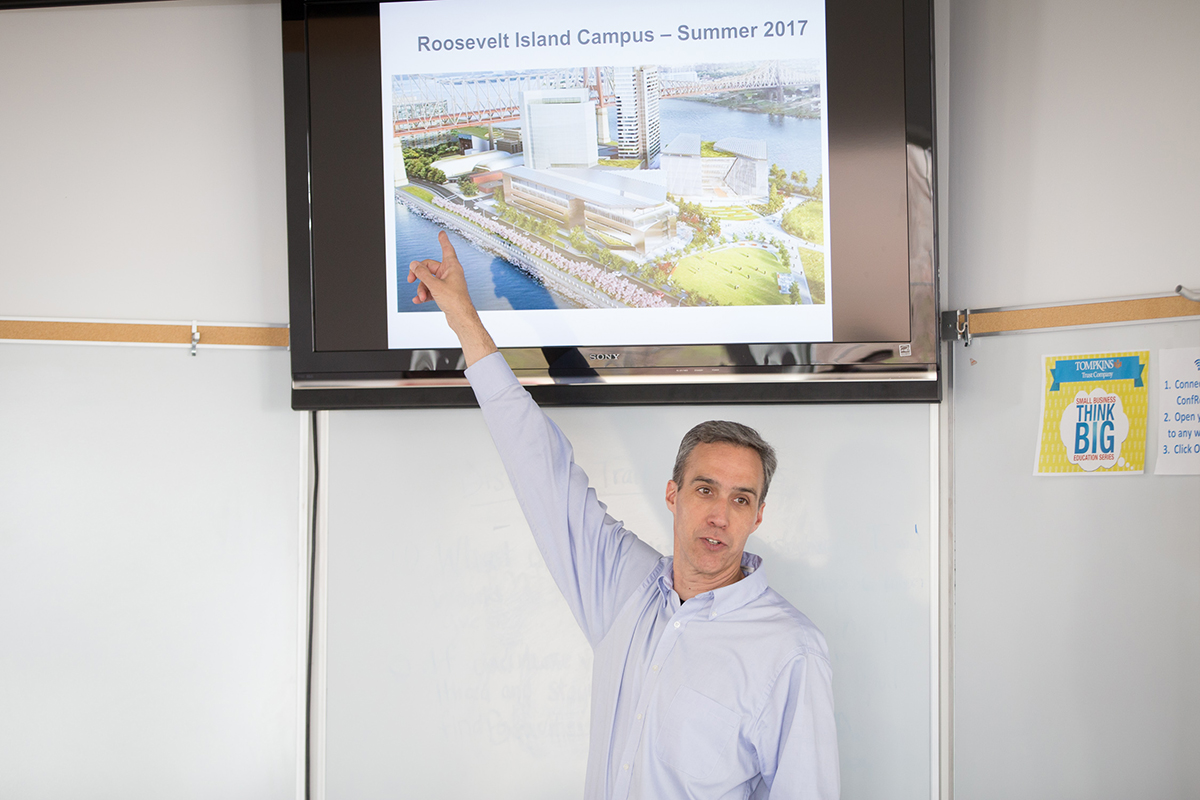Huttenlocher gives update on Cornell Tech campus
By Tom Fleischman

Dan Huttenlocher gave an update on Cornell Tech’s emerging campus on Roosevelt Island in New York City at the Tompkins County Chamber of Commerce May 3.
“I’ll be lucky if I’m alive when it’s completely built out,” the 57-year-old founding dean and vice provost of Cornell Tech said with a smile to the area business leaders.
Huttenlocher, who joined the Cornell faculty in 1988 and was named dean of Cornell Tech in 2012, spoke about the construction on Roosevelt Island, the unique collaborative environment the campus will foster and the need for a school of this kind in a changing world.
Ground was broken on the “transformative” campus in May 2015, with classes set to commence there in fall 2017 when phase one of construction is complete. Completion of the entire 12-acre campus is scheduled for 2037, and it will likely take “five to eight years to fully populate it,” Huttenlocher said.
“Sometime in the mid- to late-2040s, we’ll be fully built out and populated,” he said, “and that’s projected to be about 2,500 full-time students and 200 full-time faculty.”
At present, three buildings – The Bloomberg Center - in honor of Emma and Georgina Bloomberg (main academic building), The Bridge (corporate co-location building) and the 26-story residential tower – are under construction in the shadow of the Queensboro Bridge on the island, in the middle of the East River.
All three buildings are “topped out” – the shells are complete – and are scheduled to be ready for occupancy by July 2017. In addition, the Verizon Executive Education Center is planned for 2019 as part of phase two of the project; an adjacent hotel is also possible, although there is no developer for that project.
“Whether there is a hotel or not,” Huttenlocher said, “depends on whether developers feel that the financial risk of building something here has been ameliorated enough by the fact that there’s now three-quarters of a billion dollars’ worth of [construction in progress].”
The Bridge, Huttenlocher said, will operate under the auspices of developer Forest City Ratner of New York, which will select a company to operate the facility. It is designed to place established tech companies and fledgling startups side by side with academic researchers to bring tech to market faster.
Huttenlocher said Cornell will be working closely with Forest City Ratner as it assembles the academic and business entities in what will be a highly collaborative environment. Cornell-related educators and companies, including those spun off from Cornell Tech research, should figure prominently, he said.
The residential tower is being developed by The Hudson Companies and The Related Companies, and he said building strong relationships with outside developers is key.
“This is one of those areas where we’re trying to be really clear about what a university does best,” Huttenlocher said. “We think we do academics best; we don’t think we build and run residential buildings and office buildings well.”
Cornell Tech has 22 full-time faculty members and a total of 160 students in both master’s and doctorate programs. Currently housed in Manhattan’s Chelsea neighborhood, Cornell Tech will graduate its third class this spring and bring the total number of alumni to around 200.
Cornell Law School has partnered with Cornell Tech and will begin a Master of Laws (LLM) program this fall in New York City. Huttenlocher said Cornell Tech has hired noted legal scholar James Grimmelmann, of the University of Maryland, as its first law program faculty member.
Huttenlocher touched briefly on Cornell Tech’s commitment to K-12 education, both in New York and in the Ithaca area, which was a key component in Cornell’s winning proposal for the campus back in 2011. Huttenlocher noted that Cornell Tech will pay particular attention to students in grades five through eight, and will be fostering diversity, both gender and racial, in computer sciences.
Huttenlocher told the Chamber gathering the present day’s transformation to a digital economy is similar to the industrial transformation that was taking place in the mid-19th century.
“The country was well into industrialization in the 1860s, and that’s when the first engineering schools in the country were created,” he said, noting Cornell’s Sibley School of Mechanical Arts was among them.
“That name is very illustrative of where we are today,” he said. “Nobody knew what to call engineering in 1865. Everybody knew that there was some need for a better understanding of the mechanization that was happening with automation and with both mass organization and the manufacturing economy. ... We’re in a similar transformation now.”
Huttenlocher says he’ll be long gone by the time the ever-changing vision for Cornell Tech is fully realized, but he’s certain its mission of “rethinking graduate education for the digital age” will be a constant.
“Cornell Tech is about weaving together a set of disciplines that make sense in a digital economy and tying together academic fundamentals and real-world practice,” he said. “At that level, I don’t see Cornell Tech changing much.”
Media Contact
Get Cornell news delivered right to your inbox.
Subscribe